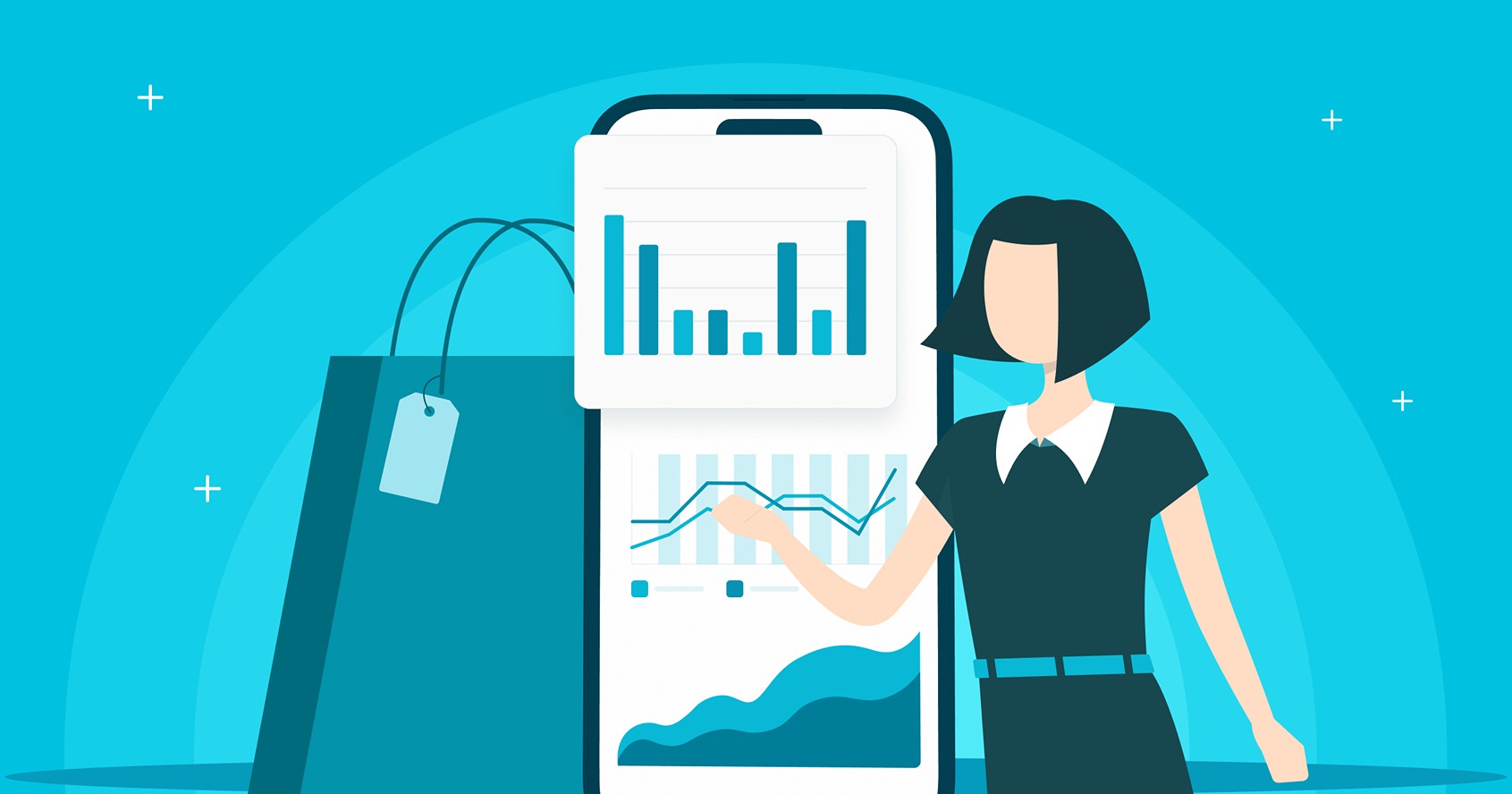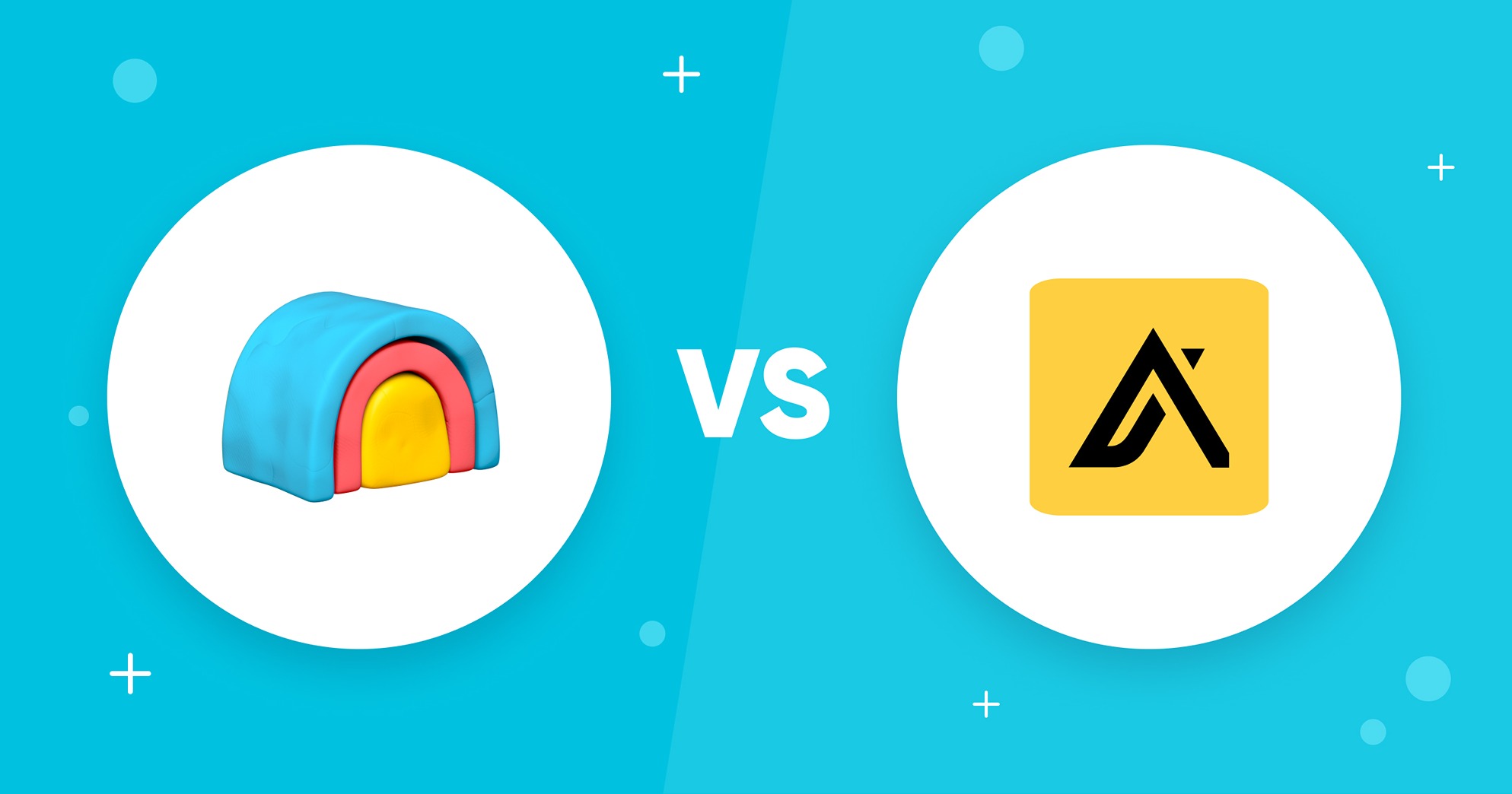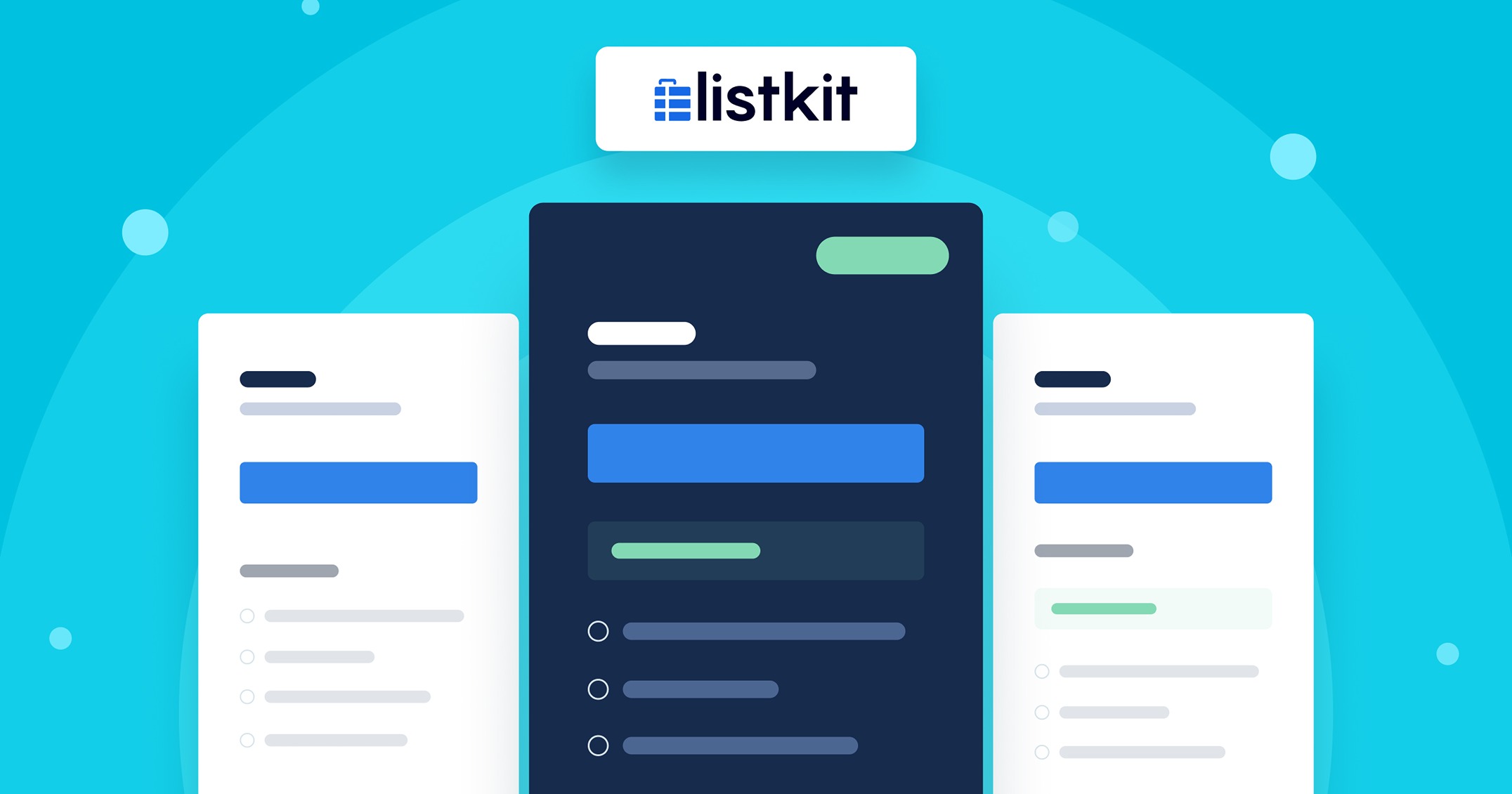A well-structured B2B marketing funnel is essential for driving growth and success in today’s rapidly evolving business landscape. This comprehensive guide will break down the components of a B2B marketing funnel and discuss its benefits and differences from B2C funnels. Moreover, you’ll find valuable strategies and tips for building a high-performing funnel that works in 2023.
What is a B2B Marketing Funnel?
In B2B marketing, understanding and optimizing your buyer’s journey is vital in driving sales and growing your business. A B2B marketing funnel is a framework that helps your company visualize and optimize this journey from initial awareness to conversion.
A B2B marketing funnel’s stages typically include awareness, interest, consideration, intent, evaluation, and action. The funnel helps your marketing team identify, attract, nurture, and convert prospects into paying customers through various sales and marketing efforts.
A well-structured B2B marketing funnel is crucial for several reasons. For one, it allows your business to target the right prospects and deliver relevant content at each stage of their journey— increasing the likelihood of conversion. It also helps allocate your sales resources more efficiently by focusing on the most impactful inbound and outbound marketing strategies. Moreover, a well-designed funnel enables your business to monitor its performance and adjust its approach, ensuring its marketing efforts remain effective and results-driven.
Benefits of a B2B Marketing Funnel
In today’s competitive business landscape, having a well-defined B2B marketing funnel is essential for B2B companies seeking to generate leads, nurture prospects, and convert them into customers. A well-defined marketing funnel can lead to a healthy sales funnel, which outlines the stages of the buyer’s journey and helps your sales team create targeted strategies that cater to prospects at each phase.
A robust marketing and sales funnel is crucial in speeding up the sales process and ensuring that resources are utilized effectively. Implementing a B2B marketing funnel leads to numerous benefits:
- Improved lead generation: By understanding the customer journey stages and creating targeted content for each phase, a B2B marketing funnel helps attract and engage potential customers, increasing the volume and quality of leads generated.
- Enhanced lead nurturing: A marketing funnel enables your sales team to tailor its messaging and outreach efforts to prospects’ specific needs and preferences at various stages– fostering stronger relationships and gradually guiding them toward conversion.
- Increased conversion rates: With a well-executed B2B marketing funnel, companies can identify and address pain points or objections during sales, resulting in higher conversion rates and more revenue.
- Better alignment between sales and marketing: A clearly defined marketing funnel helps align sales and marketing teams, ensuring that both departments work together seamlessly to move prospects through the funnel and achieve shared goals.
- Data-driven decision-making: By monitoring the funnel’s performance, your marketing team can gain valuable insights into what works and what doesn’t, enabling them to make data-driven adjustments that optimize results and drive growth.
Main Differences Between a B2B vs. B2C Marketing Funnel
B2B and B2C companies utilize marketing funnels to guide prospects through the buyer’s journey, from awareness to conversion. However, there are critical differences between B2B and B2C marketing funnels due to the distinct characteristics of their respective target markets and sales processes.
- Sales cycle duration: B2B sales cycles are typically longer and more complex than B2C, as they involve multiple decision-makers, higher price points, and a greater need for customization. This results in a more comprehensive nurturing process within the B2B sales funnel.
- Decision-making process: B2B buying decisions are often driven by logic and ROI, while B2C decisions tend to be more emotional and impulsive. To address potential concerns and demonstrate value, B2B marketing funnels must provide in-depth information, case studies, and testimonials.
- Relationship-building: B2B marketing funnels emphasize building and maintaining long-term relationships, as B2B customers often seek ongoing partnerships and solutions. B2C funnels, on the other hand, typically prioritize immediate sales and repeat purchases.
- Content and messaging: B2B marketing funnels require tailored content that addresses industry professionals’ specific needs, challenges, and expectations. B2C funnels focus more on creating content that appeals to individual consumers, emphasizing personal benefits and emotional triggers.
Stages of a B2B Marketing Funnel
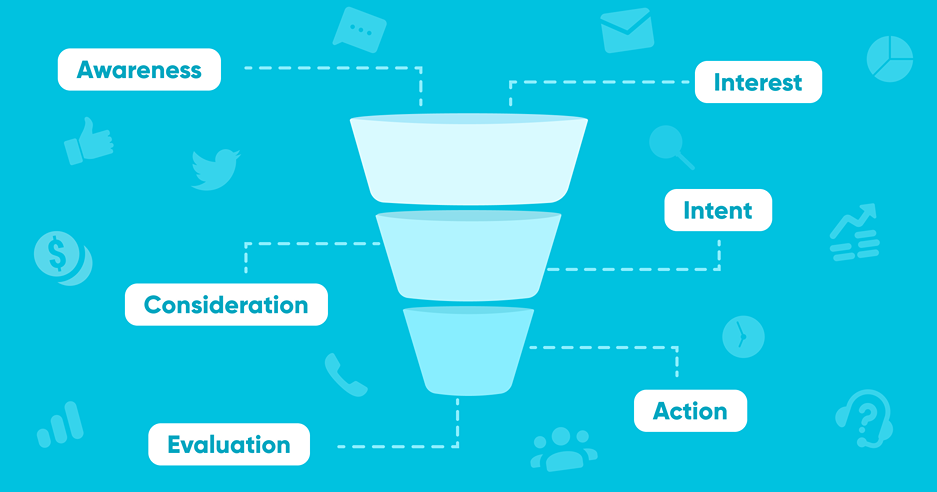
The B2B marketing funnel is a crucial framework for guiding prospects through the buyer’s journey, from initial awareness to final conversion. Understanding the stages of the funnel and the key performance indicators (KPIs) and metrics to track at each stage can help your sales and marketing team optimize their marketing strategies.
Top of the Funnel: Awareness & Interest
At the top of the funnel, the primary goal is to generate awareness and pique the interest of potential customers. This stage focuses on attracting and engaging prospects who may not be aware of your brand, products, or services.
Awareness
During the awareness stage, you aim to capture the attention of your target customer through various marketing channels, such as content marketing, search engine optimization (SEO), social media, and paid advertising. The focus is on providing value and establishing your brand as a trusted source of information in your industry.
KPIs to track at this stage include:
- Website Traffic
- Social media engagement (likes, shares, comments)
- Content engagement (views, downloads, time spent)
Interest
Once prospects become aware of your brand, the interest stage aims to nurture their curiosity and encourage them to seek more information about your products or services. This can be achieved through targeted content, such as blog posts, webinars, and whitepapers, that address common pain points and showcase the benefits of your offerings.
Metrics to track at this stage include:
- Email list growth
- Content downloads
- Webinar registrations
Middle of the Funnel: Consideration & Intent
In the middle of the funnel, the focus shifts to persuading prospects that your solution best fits their needs and nudging them toward making a purchase decision.
Consideration
Prospects actively evaluate and compare their offerings to their competitors during consideration. The goal is to showcase your unique value proposition and demonstrate how your solution addresses its specific challenges. Use case studies, product demonstrations, and testimonials to build trust and credibility.
Metrics to track at this stage include:
- Marketing qualified leads (MQLs)
- Engagement with case studies and product demos
- Time spent on product pages
Intent
In the intent stage, prospects are inclined to purchase your product or service. To capitalize on this, provide them with personalized content and offers, such as targeted email campaigns, sales consultations, or exclusive discounts, to nudge them closer to making a decision.
KPIs to track at this stage include:
- Sales qualified leads (SQLs)
- Conversion rates for targeted campaigns
- Appointment bookings
Bottom of the Funnel: Evaluation & Action
At the bottom of the funnel, the objective is to close deals and convert prospects into customers.
Evaluation
Prospects in the evaluation stage are on the verge of making a purchase decision. Addressing any remaining concerns or objections and reinforcing your value proposition is crucial. Use one-on-one sales consultations, personalized proposals, or product trials to help prospects feel confident in their decision.
KPIs to track at this stage include:
- Sales conversion rate
- Average deal size
- Time to close
Action
The action stage is where the prospect finally becomes a customer. Ensure a smooth purchasing process and provide excellent customer service to foster a positive buying experience. This stage also sets the foundation for long-term relationships, customer retention, and potential upselling or cross-selling opportunities.
KPIs to track at this stage include:
- Customer acquisition cost (CAC)
- Customer lifetime value (CLV)
- Retention rate
Lead generation doesn’t have to be all that painful. With UpLead, you can easily connect with high-quality prospects and leads to grow your company.
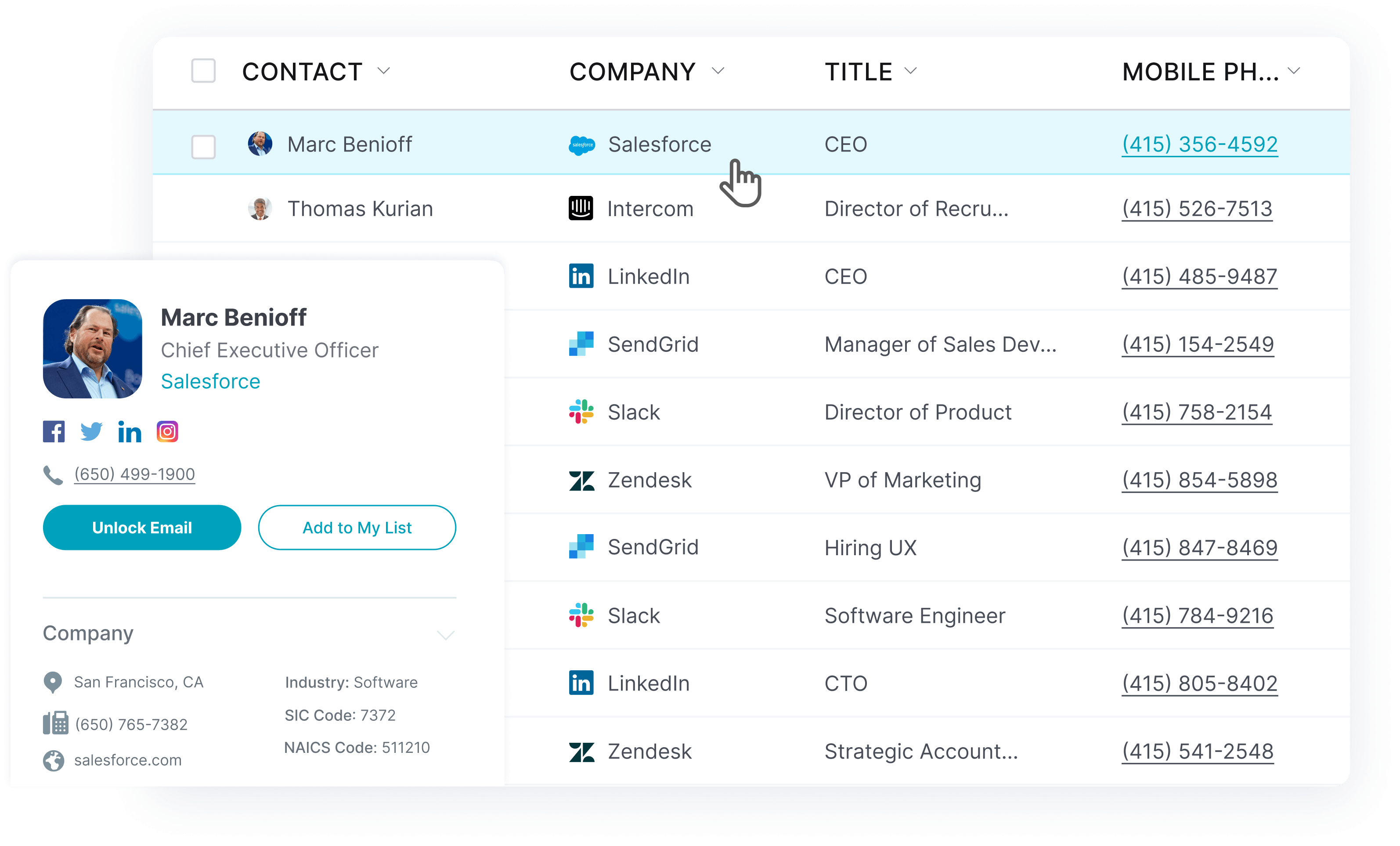
How to Build a B2B Marketing Funnel for Your Business
Building a B2B marketing funnel is essential for guiding prospects through the buyer’s journey and turning them into loyal customers. These steps can help you create a customized marketing funnel that drives results and aligns with your business objectives.
Step 1: Set Clear Goals
Before you start building your marketing funnel, it’s crucial to establish clear and measurable goals. These goals should be tied to specific business objectives, such as increasing revenue, growing market share, or improving customer retention. Setting SMART (Specific, Measurable, Achievable, Relevant, Time-bound) goals ensures your marketing funnel is focused and results-driven.
Step 2: Understand Your Ideal Client Profile
You must deeply understand your target prospects to build a successful marketing funnel. This involves creating an ideal client profile (ICP) that outlines the characteristics of your most valuable customers. Consider factors such as industry, company size, revenue, and the key decision-makers within the organization. Understanding your ICP helps tailor your marketing efforts to resonate with your target customer and deliver relevant content at each funnel stage. UpLead offers robust resources for defining your ICP and identifying prospects that match your customer profile.
Step 3: Invest in the Right Tools
Adopting the right tools is vital for building and managing a successful B2B marketing funnel. Invest in tools that help with lead generation, content creation, email marketing, and marketing automation. One such powerful tool is UpLead, a lead generation and sales intelligence platform that helps you find and connect with your ideal prospects. By integrating UpLead with your CRM and other marketing tools, you can streamline your funnel and improve the efficiency of your sales process.
Step 4: Use Different Channels
To reach a wide range of prospects and maximize the impact of your marketing funnel, leverage multiple channels to communicate with your prospects. These channels include content marketing, social media, email marketing, paid advertising, and events. Using different channels, you can increase brand visibility, engage with your audience at various touchpoints, and cater to prospects with other preferences and behaviors.
Step 5: Track and Revise Your Approach
Building a marketing funnel is an ongoing process that requires continuous monitoring and optimization. Track key performance indicators (KPIs) and metrics at each stage of the funnel to identify areas for improvement and make data-driven decisions. Regularly evaluate the effectiveness of your marketing strategies and revise your approach based on the insights gained. By consistently refining your funnel, you can ensure it remains aligned with your business goals and continues to drive results.
Key B2B Marketing Strategies
By leveraging a combination of B2B marketing tactics, your marketing team can effectively reach your target customer and achieve your marketing goals. Below are some key B2B marketing strategies and how to implement them.
Content Marketing
Content marketing involves creating and sharing valuable content to attract, engage, and retain your target audience. Position your brand as an industry thought leader by providing relevant information to address your prospects’ needs and pain points. As a result, you build trust with your audience. Content marketing works by offering value to your audience and establishing your brand as an authority in your niche. This approach helps you attract potential customers and nurture leads through their customer journey.
Below are steps to implementing a standard content marketing strategy, with some nuances to consider:
- Identify your target customers and their pain points.
- Develop a content strategy that aligns with your marketing goals.
- Create various types of content, such as blog posts, whitepapers, webinars, and videos.
- Promote your content through different channels, such as social media, email, and SEO.
- Analyze the performance of your content and refine your strategy accordingly.
SAP Boosts Content Marketing to Expand Reach
SAP successfully achieved the goal of reaching out to its customer base through a comprehensive content marketing strategy. Leveraging the digital transformation theme, SAP crafted industry-specific content and distributed it across 19 industries via multiple digital channels, including white papers, videos, infographics, blogs, surveys, and email promotions. Unprecedentedly large in scale yet thoroughly managed and executed, the campaign provided a lasting impact to engage customers while ensuring their message was heard above all of the industry noise.
Search Engine Optimization
SEO targets specific keywords and phrases your audience will likely use when searching for information related to your products or services. By ranking higher for these terms, you increase the likelihood of being found by potential customers.
Below are a few key steps to consider in building your SEO strategy:
- Conduct keyword research to identify relevant search terms.
- Optimize your website’s structure, content, and metadata for target keywords.
- Create high-quality, relevant content that answers users’ queries.
- Build backlinks from authoritative websites to improve your site’s credibility.
- Regularly monitor and analyze your SEO performance and make necessary adjustments to shifting SEO priorities.
Llama Lead Gen Builds Robust SEO Strategy
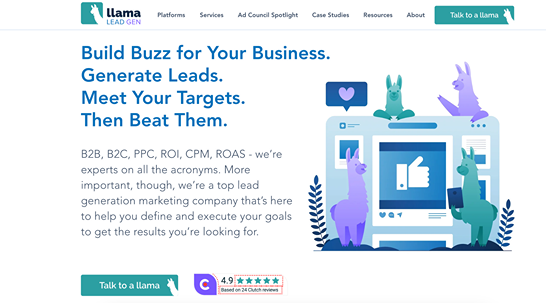
Llama Lead Gen, a B2B SaaS company looking to boost its organic search traffic, improve keyword rankings, and increase its online visibility, developed an SEO strategy to tackle the challenge. The comprehensive SEO plan involved building content around each marketing funnel stage and prioritizing long-form content to target long-tail keywords. The marketing company’s efforts paid dividends in early successes, such as a 130% increase in organic search traffic within the first three months. This was followed by a steady flow of new high-quality leads generated through organic search traffic.
Paid Advertising
Paid advertising involves running ads on various platforms, such as search engines, social media, or industry-specific websites, to reach your target audience and generate leads. This channel lets you target specific demographics, interests, and behaviors, ensuring the right audience sees your ads. PPC ads have been shown to generate twice as much traffic as SEO tactics.
Below are key steps to implementing a paid advertising campaign:
- Identify the most suitable advertising platforms for your marketing campaign.
- Set a budget and bidding strategy.
- Create compelling ad copy and visuals.
- Target your ads based on relevant criteria, such as demographics, interests, or job titles.
- Monitor and optimize your ad performance for maximum ROI. If certain ads aren’t contributing to your conversion goals, you’ll better understand what works and what doesn’t.
Tools like Zeropark or Wordstream can help you track and optimize your PPC campaigns.
Snagajob Uses LinkedIn Ads to Lower Cost Per Lead
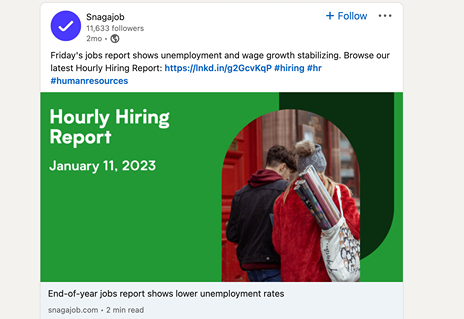
Snagajob successfully utilized LinkedIn ads to capture its target customer’s attention and drive results. The company created a more engaging experience that resonated with potential leads by employing video ads tailored to its audience. As a result of its well-executed campaign, Snagajob saw an impressive 84% increase in converted leads. Additionally, this targeted paid advertising approach led to a lower cost per lead, as they could earn more applicants for its platform.
Email Marketing
Email marketing allows you to establish direct communication with your audience and deliver targeted, relevant content straight to their inboxes. This approach helps build trust, maintain relationships, and encourage prospects to take action at different stages of the buyer’s journey. Since emails can be personalized and segmented, they efficiently deliver the right message to the right audience at the right time. According to a Hubspot study, email marketing usage will continue to grow, with 22% of marketers planning to implement it for the first time.
Below are essential steps to implement a robust email marketing strategy for your organization.
- Build a quality email list by encouraging visitors to your website, social media profiles, or events to sign up for your mailing list while offering valuable content or incentives, such as ebooks, whitepapers, or discounts.
- Divide your B2B email list into segments based on criteria such as industry, job title, or engagement level to tailor your messaging and provide relevant content to each group.
- Develop compelling email content that resonates with your audience and addresses their needs and pain points. Use a mix of promotional, educational, and relationship-building content to maintain a balanced approach.
- Use personalization techniques, including the recipient’s name or referring to their specific interests, to make your emails more engaging and relevant.
- Regularly test different email elements, such as subject lines, send times, or call-to-action placements, to determine what works best for your audience. Analyze your email performance, and refine your email approach accordingly.
Dropbox Builds Clear-Cut Email Strategy
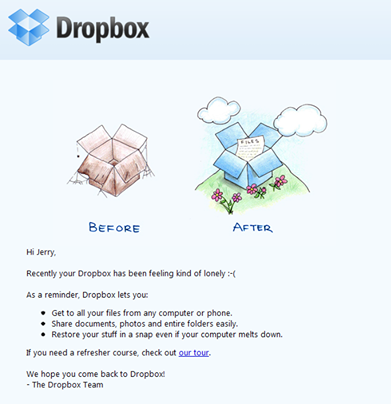
A growing trend among top email marketers is shifting focus from elaborate copy to stunning designs. While long-form copy can be compelling for personality-driven companies, brands not reliant on a brand leader can benefit from simple, visually appealing designs. Dropbox, a $10 billion online storage service, exemplifies this approach through its minimalist design and simplicity. This tactic includes its personable email sent after subscription cancellations. Instead of using long, benefit-focused copy, Dropbox prioritizes design and concise product-based content to get the message across faster.
Tips for Creating an Effective B2B Marketing Funnel
An effective B2B marketing funnel is crucial for guiding prospects through the various stages of the buyer’s journey, from awareness to conversion. To build a successful marketing funnel, you must adopt a combination of strategies that align with your objectives and resonate with your target audience. Below are four critical tips for creating a powerful B2B marketing funnel.
Market a Solution
In developing a marketing strategy, it’s important to focus on presenting your products or services as solutions to your potential customer’s challenges and pain points. By addressing their needs and demonstrating how your offerings can help, you position your brand as a valuable resource and build trust with potential customers.
Marketing a solution enables you to connect with your audience on a deeper level, fostering long-term relationships and driving loyalty. Research shows that B2B customers value a problem-solving approach and are likelier to engage with companies that understand their needs.
Always Strive to Add Value
To build an effective B2B marketing funnel, consistently aim to provide compelling value to your prospects at every stage of their journey. This can be achieved through various means, such as offering insightful content, sharing industry expertise, or providing personalized recommendations.
Adding value is critical to building trust and establishing long-term customer relationships. According to a study by Edelman, trust is a crucial factor influencing B2B buyers’ decisions. Businesses that consistently deliver value are likelier to earn their customers’ trust and loyalty.
Target the Right Customers
To optimize your marketing funnel, ensure you’re targeting the right customers by creating detailed buyer personas and using tools like UpLead to identify and connect with prospects that match your ideal client profile. Focusing on the right audience increases the likelihood of generating high-quality leads and converting them into customers.
Automate the Process
Leverage marketing automation tools to streamline your B2B marketing funnel and ensure prospects receive timely, relevant content at each journey stage. By automating tasks such as lead nurturing, customer segmentation, and analytics, you can increase the efficiency and effectiveness of your marketing efforts.
Boost Your B2B Marketing Funnel With UpLead
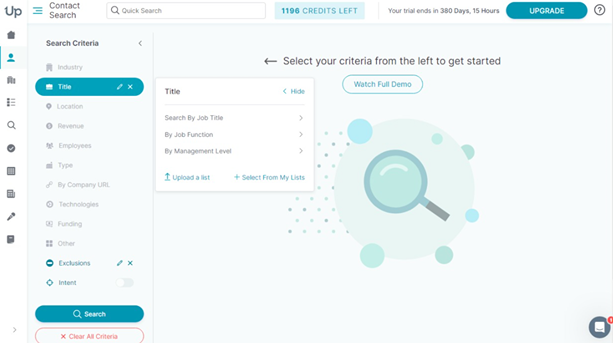
Consistently working towards enhancing your B2B marketing funnel is crucial for generating leads and driving conversions. UpLead is a powerful B2B prospecting and sales intelligence tool designed to help your sales and marketing team optimize its marketing funnels and maximize results. Here’s why UpLead is a top choice for B2B marketers:
- Access to 160M+ million verified B2B contacts
- Advanced search and filtering options with the ability to create highly-targeted lists based on industry, job title, company size, and more
- UpLead verifies email addresses in real-time, ensuring you have accurate contact information and improving your email deliverability rates
- UpLead’s data enrichment feature helps you keep your contact information up-to-date, ensuring your sales and marketing efforts remain relevant
Boost your B2B marketing funnel today by leveraging the power of UpLead. Access a wealth of verified B2B contacts and benefit from advanced targeting options that allow you to connect with the right prospects.
Start your free trial with UpLead now and elevate your B2B marketing strategy.
What You Need to Remember About B2B Marketing Funnels
Building a B2B marketing and sales funnel that delivers results requires a clear understanding of the stages, the right strategies, and the ability to adapt your approach. By following the tips and best practices outlined in this guide, you can create a powerful B2B marketing funnel that targets the right customers, adds value, and ultimately drives the success of your business. Leverage tools like UpLead to optimize your funnel and stay ahead of the competition in 2023 and beyond.

